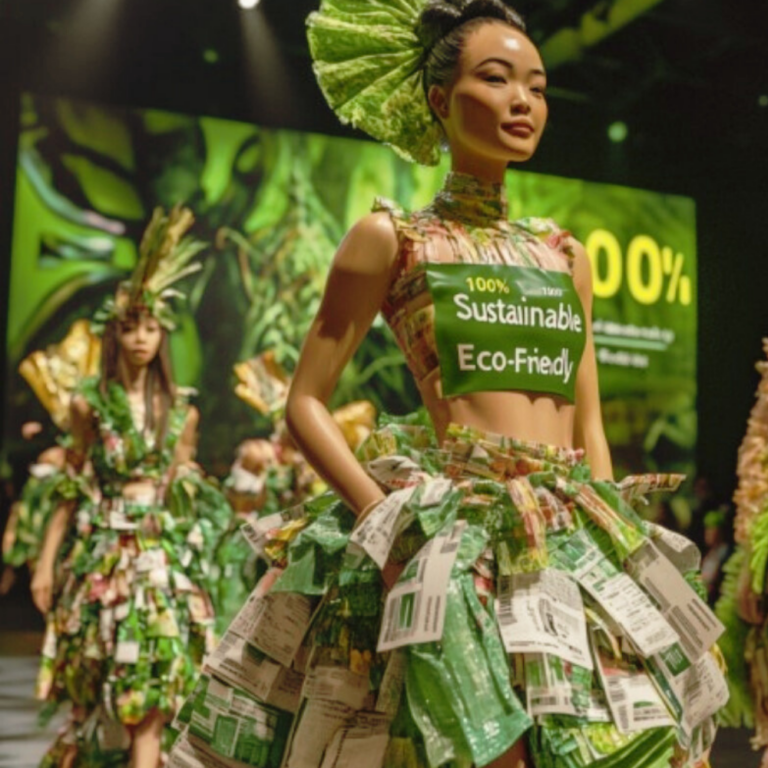
Key Takeaways
- Recycled polyester (rPET) turns used plastic bottles into new fabric, helping reduce waste and pollution.
- Making rPET uses less water and energy than virgin polyester, cutting down on carbon emissions.
- While it still sheds microplastics, choosing recycled polyester supports a more sustainable fashion industry.
Did you know it takes about 10 plastic bottles to make one piece of clothing from recycled polyester? That’s wild! Every year, millions of plastic bottles end up in landfills and oceans, adding to our growing waste problem. But instead of becoming trash, some of that plastic gets a second life as fabric. What used to be a water bottle can now turn into activewear, jackets, and even high-fashion pieces.
The fashion industry has a significant environmental footprint, from water-hungry cotton to synthetic fabrics made from oil. Recycled polyester, also known as rPET, helps reduce that impact by using less energy and keeping plastic out of the waste stream a little longer. It’s not a perfect fix, but it’s a meaningful step toward more sustainable fashion and a cleaner planet.
What Is Recycled Polyester?
Polyester is one of the most common fabrics in the world, but many people don’t realize it’s actually a type of plastic. It’s made from petroleum, the same material used to make plastic bottles. Regular, or “virgin,” polyester starts with oil, which is processed into tiny pellets, melted, and spun into fibers that become fabric. It’s strong, stretchy, and long-lasting, but making it uses a lot of energy and fossil fuels.
Recycled polyester, also called rPET, changes that story. Instead of starting with new oil, it’s made from existing plastic, usually old water bottles or worn-out textiles. The plastic is collected, cleaned, and turned into fibers that can be woven into new fabric.
This process helps reduce waste and lowers the need for new petroleum. In short, recycled polyester gives plastic a second life while cutting down on the pollution and resource use tied to making new fabric.
Is Recycled Polyester Safe to Wear?
Yes — recycled polyester (rPET) is generally considered safe to wear. The plastic bottles used to make it are thoroughly cleaned and processed before they ever become fabric. During recycling, the plastic is melted at high temperatures, which removes most residues and contaminants. Reputable manufacturers also follow strict safety standards, such as the Global Recycled Standard (GRS) and OEKO-TEX, to make sure the finished fabric is free from harmful chemicals.
That said, there are a few things to keep in mind. While rPET is safe for everyday wear, it still sheds microplastics when washed, just like regular polyester. These tiny fibers can end up in waterways and harm marine life. To reduce shedding, you can:
- Wash your clothes less often
- Use a Guppyfriend bag or microfiber filter
- Choose air drying instead of machine drying
If you have very sensitive skin, you might prefer natural fabrics like organic cotton or hemp, since they’re less likely to irritate. But for most people, recycled polyester clothing is safe, comfortable, and no riskier to wear than traditional polyester.
How Recycled Plastic is Made

Ever wondered how a plastic bottle turns into a piece of clothing? The process is both clever and efficient. It starts with collecting and sorting used plastic bottles, mainly water and soda bottles that might otherwise end up in landfills or the ocean.
The bottles are then carefully cleaned to remove labels, glue, and any leftover residue before being shredded into tiny plastic flakes.
Next, the clean flakes are melted and turned into small pellets called rPET chips. These pellets are heated again and pushed through fine nozzles to form long, thread-like fibers. The fibers are stretched, spun into yarn, and then woven or knitted into fabric that’s ready to be made into clothing.
This process gives plastic waste a second life and reduces the need for new polyester, making it a smarter, more sustainable option for the fashion industry.
Don’t Miss: The Truth About Plastic – Why Plastic-Free Living Matters Want to learn more about why switching to plastic alternatives matters? This guide breaks down the impact of plastic and how small swaps can make a big difference. Read more →Recycled Polyester vs. Virgin Polyester: Which One’s Better?
Polyester dominates the fashion industry it’s in everything from leggings to backpacks, fast fashion to high-end gear. However, not all polyester is created equal. Is recycled polyester (rPET) better than virgin polyester, or is it just another greenwashing tactic?
Virgin Polyester: The Fossil Fuel Problem
Virgin polyester is made from petroleum, a fossil fuel that requires drilling, refining, and significant energy to turn into fabric. The process is resource-intensive, emitting nearly three times the amount of CO₂ as cotton production and consuming vast amounts of water and chemicals. Worse, polyester isn’t biodegradable; it sticks around in landfills for centuries, breaking down into microplastics that contaminate soil and water.
Given the environmental cost, it’s clear that making polyester from scratch is far from sustainable. This is where recycled polyester steps in as a potential solution.
Why Recycled Polyester is the More Sustainable Option
Recycled polyester (rPET) is made by repurposing existing plastic—primarily discarded water bottles but also old polyester fabric. Instead of relying on virgin petroleum, rPET gives waste a second life, significantly reducing its environmental footprint.
Here’s why rPET is a step in the right direction:
- Less plastic waste: Each ton of rPET fabric saves thousands of bottles from landfills and oceans.
- Lower energy use: Making recycled polyester uses about 59% less energy than virgin polyester.
- Fewer carbon emissions: It cuts greenhouse gases by roughly 32%.
- Water savings: rPET uses about 63% less water than virgin polyester.
While it’s not a perfect fix, using recycled polyester is undeniably better than continuing to churn out new plastic-based fabrics.
Benefits of Recycled Polyester
Recycled polyester, or rPET, has become one of the most popular materials in sustainable fashion — and for good reason. It helps tackle plastic waste while reducing the demand for new fossil fuels. Here are some of the most significant benefits that make rPET a smarter choice for both brands and consumers.
🌎 It Keeps Plastic Out of Landfills and Oceans
Every ton of recycled polyester saves thousands of plastic bottles from becoming trash. Instead of sitting in a landfill or floating in the ocean, those bottles are transformed into something useful, like clothing, bags, or home textiles.
This reuse also takes pressure off recycling centers that are already overloaded with plastic waste. Some experts note it’s best when fashion recycling doesn’t replace bottle-to-bottle programs, but overall, recycled polyethylene terephthalate (rPET) keeps more plastic in use and out of nature.
⚡ It Uses Less Energy and Water
Making recycled polyester uses about 59% less energy and roughly 63% less water than creating virgin polyester from new oil. That means fewer fossil fuels burned and a smaller impact on the planet’s water supply. Some factories are switching to renewable energy, making the process cleaner and more climate-friendly.
💨 It Reduces Carbon Emissions
By skipping the oil extraction and refining steps, recycled polyester can lower carbon emissions by nearly one-third. That’s a big win for cutting pollution and helping fashion brands move closer to global climate goals.
👕 It’s Durable and Easy to Care For
Just like regular polyester, rPET fabrics are strong, lightweight, and wrinkle-resistant. They dry quickly, last for years, and don’t require special washing routines, making them practical for everyday wear. Long-lasting clothes also mean less waste overall. For extra sustainability, using a wash bag or filter can help reduce microplastic shedding when you do laundry.
🧵 It’s Becoming More Available
Recycled polyester is gaining traction across the fashion world, showing that sustainability and style can go hand in hand. Many well-known brands now use rPET in their products. Patagonia and Adidas have pioneered their use in jackets, leggings, and sneakers, while the Girlfriend Collective makes workout gear almost entirely from recycled bottles.
Luxury and sustainable brands like Stella McCartney and Eileen Fisher also include rPET in their high-end designs, proving that eco-conscious fashion can still look and feel luxurious. Beyond clothing, you’ll find recycled polyester in backpacks, blankets, rugs, and other home items, expanding its reach far beyond the closet.
When shopping, look for certifications such as the Global Recycled Standard (GRS) or a “Made with rPET” label to ensure the fabric meets quality and environmental standards.
The Drawbacks: Not a Perfect Solution
While recycled polyester is a big step forward, it’s not a perfect solution. It still has a few challenges that limit how sustainable it can genuinely be.
Microplastic Pollution
Just like virgin polyester, rPET sheds microplastics when washed. These tiny fibers can slip through wastewater filters and end up in rivers and oceans. Over time, they can harm marine life and even enter the food chain. You can help reduce this by washing less often, using a Guppyfriend bag or microfiber filter, and air-drying your clothes whenever possible.
Limited Recyclability
Recycled polyester can’t be recycled forever. Each time it’s processed, the fibers lose some strength and quality. Eventually, even rPET fabrics reach the end of their life and may end up as waste. Unlike materials such as aluminum, polyester can only go through a few recycling cycles before breaking down.
Quality and Color Challenges
The quality of recycled polyester can vary depending on the source and recycling method. It can be harder to control fabric color, texture, and consistency compared to virgin polyester. That can make large-scale manufacturing more complicated or costly for some brands.
Disruption to Bottle Recycling
Some experts worry that the fashion industry’s demand for rPET could divert plastic bottles away from bottle-to-bottle recycling programs, which are more circular. Balancing textile recycling with packaging recycling is an ongoing challenge.
Cost and Accessibility
Because rPET requires specialized equipment and sorting systems, it’s still more expensive to produce than virgin polyester in many regions. While prices are improving, not all brands or consumers have easy access to recycled options yet.
Don’t Miss: Microplastics – Health Risks, Sources, and How to Reduce Exposure 👉 Learn how microplastics affect our bodies and the environment — plus simple ways to lower your daily exposure. Read more →FAQs on What Is Recycled Polyester
Sort of — but not forever. When plastic bottles are turned into fabric, the fibers weaken a little each time they’re processed. That means recycled polyester can only go through a few recycling rounds before it loses quality. It’s still better than making new polyester from oil, but it’s not an endless loop.
It depends on how it’s made. Some recycled polyester fabrics are just as strong and soft as virgin polyester, primarily when high-quality recycling methods are used. But lower-grade versions can feel thinner or wear out faster. In general, good brands using certified materials tend to produce longer-lasting rPET.
Look for clear details on the label or website. Certifications like the Global Recycled Standard (GRS) or a “Made with rPET” tag show that the material meets sustainability standards. Be cautious of vague claims like “made with recycled materials” if they don’t say how much or what kind. Brands that share where their recycled fabric comes from are usually the most trustworthy.
Not really — most people can’t tell the difference. Recycled polyester has the same lightweight, stretchy feel and dries quickly, just like regular polyester. The only slight difference might be that rPET can feel slightly softer depending on how it’s processed.
This Has Been About Recycled Polyester
Recycled polyester isn’t a perfect fabric, but it’s a meaningful step in the right direction. By turning old plastic bottles into clothing, we’re keeping waste out of landfills and using fewer new resources. It helps lower carbon emissions, saves water, and gives everyday items a second life.
Still, it’s important to remember that recycled polyester is still plastic. It can shed microplastics and can’t be recycled forever. The best thing we can do is buy less, choose better quality, and take care of the clothes we already own.
When you need something new, choosing recycled polyester over virgin polyester is the smarter, more eco-friendly option. Small changes like this, multiplied by millions of people, can make a real difference for the planet.
Don’t Miss: The Slow Fashion Movement Want to make more mindful clothing choices? Learn how slow fashion helps reduce waste and supports a cleaner, more sustainable future. Read more →🗨️ Have you tried clothing made from recycled polyester? Tell us what you think in the comments below!
📚 References
- Reishore Clothing. (n.d.). Our process. Reishore Clothing. https://reishoreclothing.com/our-process/
- Swiss Federal Office for the Environment. (2017, December). Recycled textile fibres and textile recycling [PDF]. Swiss Confederation. https://www.bafu.admin.ch/dam/bafu/en/dokumente/wirtschaft-konsum/externe-studien-berichte/Recycled-Textile-Fibres-and-Textile-Recycling.pdf.download.pdf/study-on-recycled-textiles-and-textile-recyclability-ch.pdf
- Qian, W., Ji, X., Xu, P., & Wang, L. (2021). Carbon footprint and water footprint assessment of virgin and recycled polyester textiles. Textile Research Journal, 91(11–12), 1335–1346. https://journals.sagepub.com/doi/10.1177/00405175211006213






